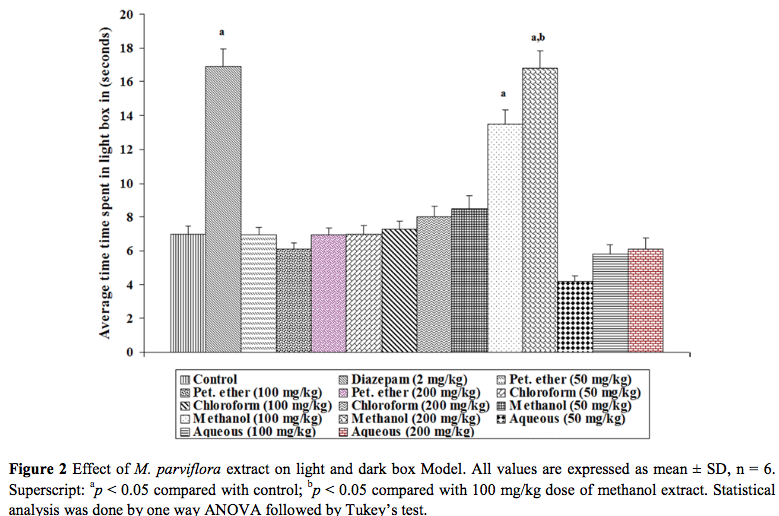
Evaluation of anti-anxiety activity of Melissa parviflora (Benth.) in rats
Abstract
Objective: Melissa parviflora Benth. (Family: Lamiaceae) has been traditionally used as a tranquillizer, relaxants, nervine and sleeping aids throughout the world. The plant is reported to relieve tension and stress reactions, and widely valued for its calming properties. Despite a long tradition of uses, no scientific pharmacological work has ever been carried out on this potential plant. Therefore, the present study was design to evaluate anti-anxiety activity of M. parviflora in rats. Various extracts viz. petroleum ether, chloroform, methanol and aqueous were prepared by successive soxhlet extraction method. Anxiolytic activity of various extracts of the plant was evaluated using elevated plus-maze apparatus and light and dark test model of anxiety in Wistar rats of either sex. The bioactive extract was standardized on the basis of total phenolic and flavonoid content estimation using colorimetric method. Results showed that only methanol extract of M. parviflora exhibited significant anxiolytic activity (100 and 200 mg/kg, p.o.) using elevated plus maze test and light and dark test models of anxiety with respect to vehicle treated control and diazepam (2 mg/kg, p.o.) as positive control. The total phenolic and flavonoid content in the bioactive methanol extract was estimated to be 15.21 ± 0.72 mg gallic acid equivalents, and 8.06 ± 0.58 mg rutin equivalents per gram of the extract, respectively. The present study leads to the conclusion that methanol extract of the plant showed predominantly anxiolytic activity. Therefore, M. parviflora could serve as a new approach for the treatment of CNS disorders like anxiety.
Full Text:
70-75:PDFReferences
R. C. Kessler and P. S. Wang. The descriptive epidemiology of commonly occurring mental disorders in the United States, Ann. Rev. Pub. Health. 29: 115-129, 2008.
R. C. Kessler, P. Berglund, O. Demler, et al. Lifetime prevalence and age-of-onset distributions of DSM-IV disorders in the National comorbidity survey replication, Arch. Gen. Psych. 62: 593-602, 2005a.
B. O. Olatunji, J. M. Cisler and D. F. Tolin. Quality of life in anxiety disorders: a meta- analytic review, Clin. Psychol. Rev. 27: 572-581, 2007.
J. P. Lepine. The epidemiology of anxiety disorders: prevalence and societal costs, J. Clin. Psych. 63: 14-18, 2002.
K. Rickels and E. Schweizer. The clinical presentation of generalized anxiety in primarycare setting: practical concepts of classification and management, J. Clin. Psych. 58, 4-9, 1997.
L. Y. Chung, S. H. Goh and Z. Imiyabir. Central nervous system receptor activities of some Malaysian plant species, Pharmaceut. Biol, 43: 280- 288, 2005.
A. S. Kumar and R. Gandhimathi Effect of guettarda speciosa extracts on biogenic amines concentrations in rat brain after induction of seizure, Int. J. Pharm. Pharmaceut. Sci, 1: 237-243, 2009.
A. Rex, E. Morgenstern and H. Fink. Anxiolytic-like effects of Kava-Kava in the elevated plus maze test-a comparison with diazepam, Prog. Neuropsychopharmacol. Biol. Psych. 26, 855-860, 2002.
G. Elkins, M. H. Rajab and J. Marcus. Complementary and alternative medicine use by psychiatric inpatients, Psychol. Rep. 96: 163-166, 2005.
R. N. Chopra and I. C. Chopra. Indigenous drugs of India: Academic publishers; 1958.
K. R. Kirtikar and B. D. Basu and E. Blatter. Indian medicinal plants, 1975.
P. Scartezzini and E. Speroni. Review on some plants of Indian traditional medicine with antioxidant activity, J. Ethnopharmacol. 71: 23-43, 2000.
D. O. Kennedy, W. Little and A. B. Scholey. Attenuation of laboratory-induced stress in humans after acute administration of Melissa officinalis (lemon balm), Psychosomat Med. 66: 607-613, 2004.
H. Moradkhani, E. Sargsyan and H. Bibak. Melissa officinalis L. a valuable medicine plant, J. Med. Plants Res. 4: 2753-2759, 2010.
W. C. Evans. Trease and Evans' Pharmacognosy: 16th edition; 2009.
K. R. Khandelwal. Practical Pharmacognosy: Nineteenth edition, Nirali Prakashan, Maharshtra; 2009.
J. Y. Lin and C. Y. Tang. Determination of total phenolic and flavonoid contents in selected fruits and vegetables, as well as their stimulatory effect on mouse splenocyte proliferation, Food Chem. 101: 140-148, 2007.
M. A. Hossain, M. D. Muhammad, G. Charles and I. Muhammad. In vitro total phenolics, flavonoids contents and antioxidant activity of essential oil, various organic extracts from the leaves of tropical medicinal plant Tetrastigma from Sabah, Asian Pac. J. Trop. Med. 4(9): 717-721, 2011.
Organization of Economic Co-operationand Development (OECD) [online]. The OECD Guidelines for Testing of Chemical: 423 Acute Oral Toxicity, France; 2001 [cited 2014 August 10]. Available from: http://ntp.niehs.nih.gov/iccvam/suppdocs/feddocs/oecd/oecd_gl420.pdf.
S. Pellow, P. H. Chopin, S. E. File and M. Briley. Validation of open:closed arm entries in an elevated plus-maze as a measure of anxiety in the rat, J. Neurosci. Meth. 14(3):149-167, 1985.
A. C. Sharma and S. K. Kulkarni. MK-801 produces antianxiety effect in elevated plus-maze in mice, Drug Dev. Res. 22: 251-258, 1991.
M. Hascoet and M. Bourin. A new approach to the light or dark test procedure in mice. Pharmacol. Biochem. Behav. 60: 645-653, 1998.
M. Bourin and M. Hascoet. The mouse light/dark test, Eur. J. Pharmacol. 463: 55-65, 2003.
S. A. Hoggs. Review of the validity and variability of the elevated plus maze as an animal model of anxiety, Pharmacol. Biochem. Behav. 54: 21-30, 1996.
S. Pellow, P. H. Chopin, S. E. File and M. Briley. Validation of open: closed arm entries in an elevated plus-maze as a measure of anxiety in the rat, J. Neurosci. Meth. 14: 149-167, 1985.
J. Crawley and F. K. Goodwin. Preliminary report of a simple animal behavior model for the anxiolytic effects of benzodiazepines, Pharmacol. Biochem. Behav. 13: 167-170, 1980.
J. N. Crawley, P. J. Marangos, S. M. Paul, P. Skolnick and F. K. Goodwin. Interaction between purine and benzodiazepine: Inosine reverses diazepam-induced stimulation of mouse exploratory behavior, Science. 211: 725-727, 1981.
H. Nishikava, T. Hata and Y. Funakami. A role for corticotrophin releasing factor in repeated cold stress-induced anxiety-like behavior during forced swimming and elevated plus-maze test in mice, Biol. Pharm. Bull. 27: 352-356, 2004.
Refbacks
- There are currently no refbacks.

